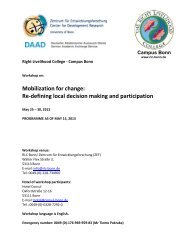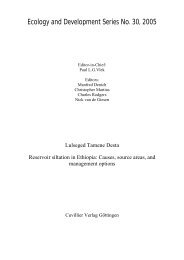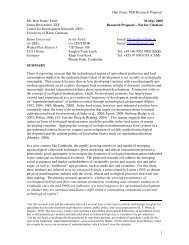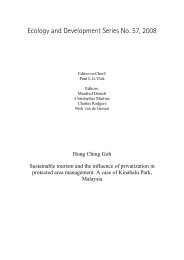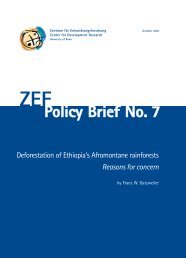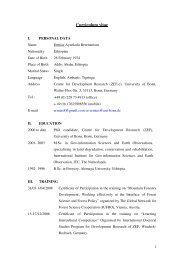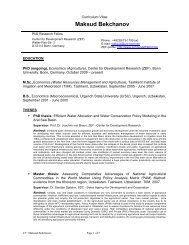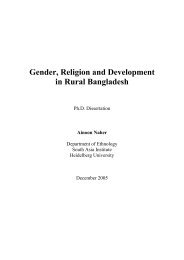Ecology and Development Series No. 10, 2003 - ZEF
Ecology and Development Series No. 10, 2003 - ZEF
Ecology and Development Series No. 10, 2003 - ZEF
- No tags were found...
You also want an ePaper? Increase the reach of your titles
YUMPU automatically turns print PDFs into web optimized ePapers that Google loves.
Current state of knowledgeBroader attempts to underst<strong>and</strong> the country’s forest vegetation <strong>and</strong> itsclassification were made during the second half of the 20 th century. Some researchersassessed the vegetation classes subjectively based on the similarities in geographicaldistribution to the other East African countries (e.g., Hedberg 1951; Coetzee 1978), whileothers (Hamilton 1982) based their classification on altitude <strong>and</strong> moisture distribution. Themost significant early contributions to the classification of the vegetation of Ethiopia werethose of Pichi-Sermolli (1957) <strong>and</strong> von Breitenbach (1963). Pichi-Sermolli’s work was theearliest <strong>and</strong> most detailed map of the vegetation types of Ethiopia (Friis 1992), coveringalso Djibouti, Eritrea <strong>and</strong> Somalia. He recognized 24 vegetation units. Most of thevegetation units are physiognomic. This system was used to compile the first AETFATvegetation map of Africa (Keay 1959). Later, von Breitenbach (1963) published a moredetailed vegetation map of Ethiopia, building upon the same system. The boundaries of thevegetation maps of von Breitenbach are quite similar to those of Pichi-Sermolli, except forthe differences in the terminologies for naming the vegetation types (Friis <strong>and</strong> Sebsebe2001). The main difference between this classification <strong>and</strong> that of Pichi-Sermolli is that it isa much more detailed <strong>and</strong> rigid classification, based on physiognomy in relation to altitude,humidity <strong>and</strong> presumed stage of succession (Friis <strong>and</strong> Sebsebe 2001). Von Breitenbachused seven vegetation categories for mapping, which he further classified into 82, providingcomplex <strong>and</strong> detailed vegetation types, mainly based on “associations”. Classification ofvegetation into “association” based on presumed stage of succession at certain altitudes <strong>and</strong>degrees of humidity, differs in concept <strong>and</strong> methodology from the ‘association’ commonlyused by the Zurich-Montpelier School of phytosciologists (Braun-Blanquet 1932; Westhoff<strong>and</strong> Van der Maarel 1978). The system of Von Breitenbach is poorly documented <strong>and</strong> lacksessential information on locations <strong>and</strong> distribution (Friis et al. 1982).The most widely accepted system of vegetation types for Africa is that ofGreenway (1973), which was adopted for the vegetation map of southwestern Ethiopia(Friis et al. 1982). This system is physiognomic, <strong>and</strong> can also easily accommodate a moredetailed system based on “associations”. It was also used as a basis to produce the secondvegetation map of Africa <strong>and</strong> the accompanying descriptive memoir (White 1983).<strong>10</strong>



